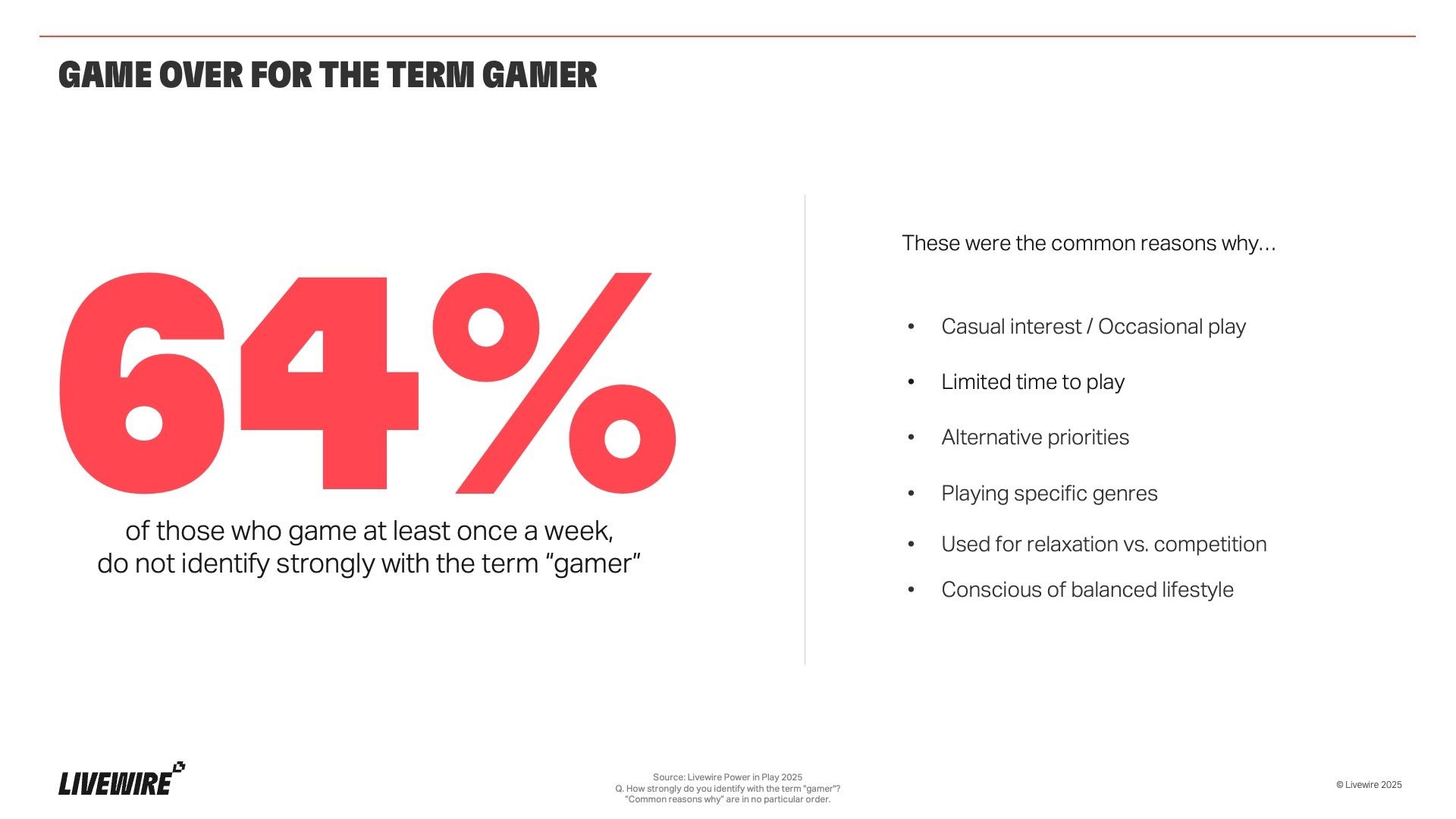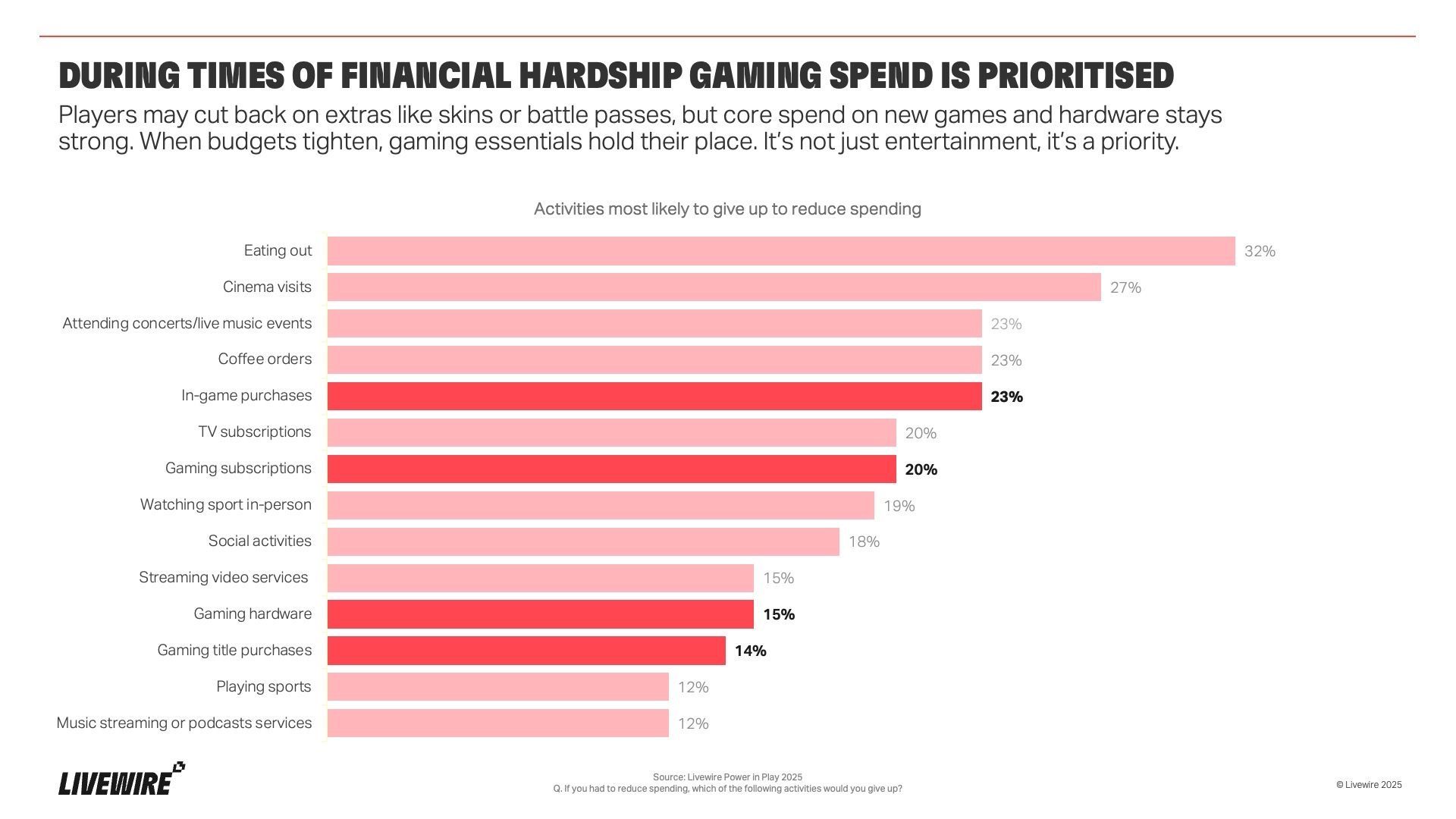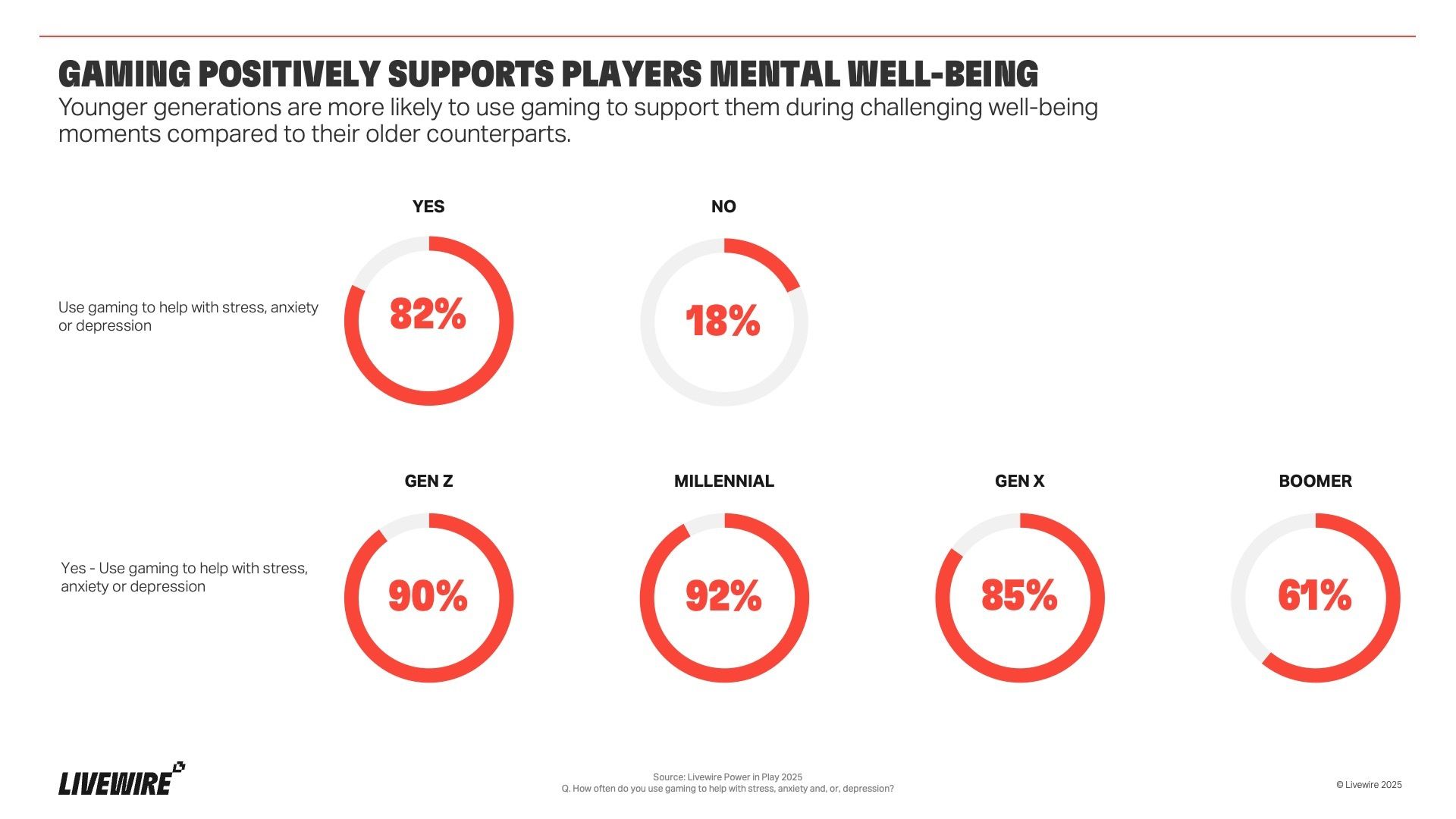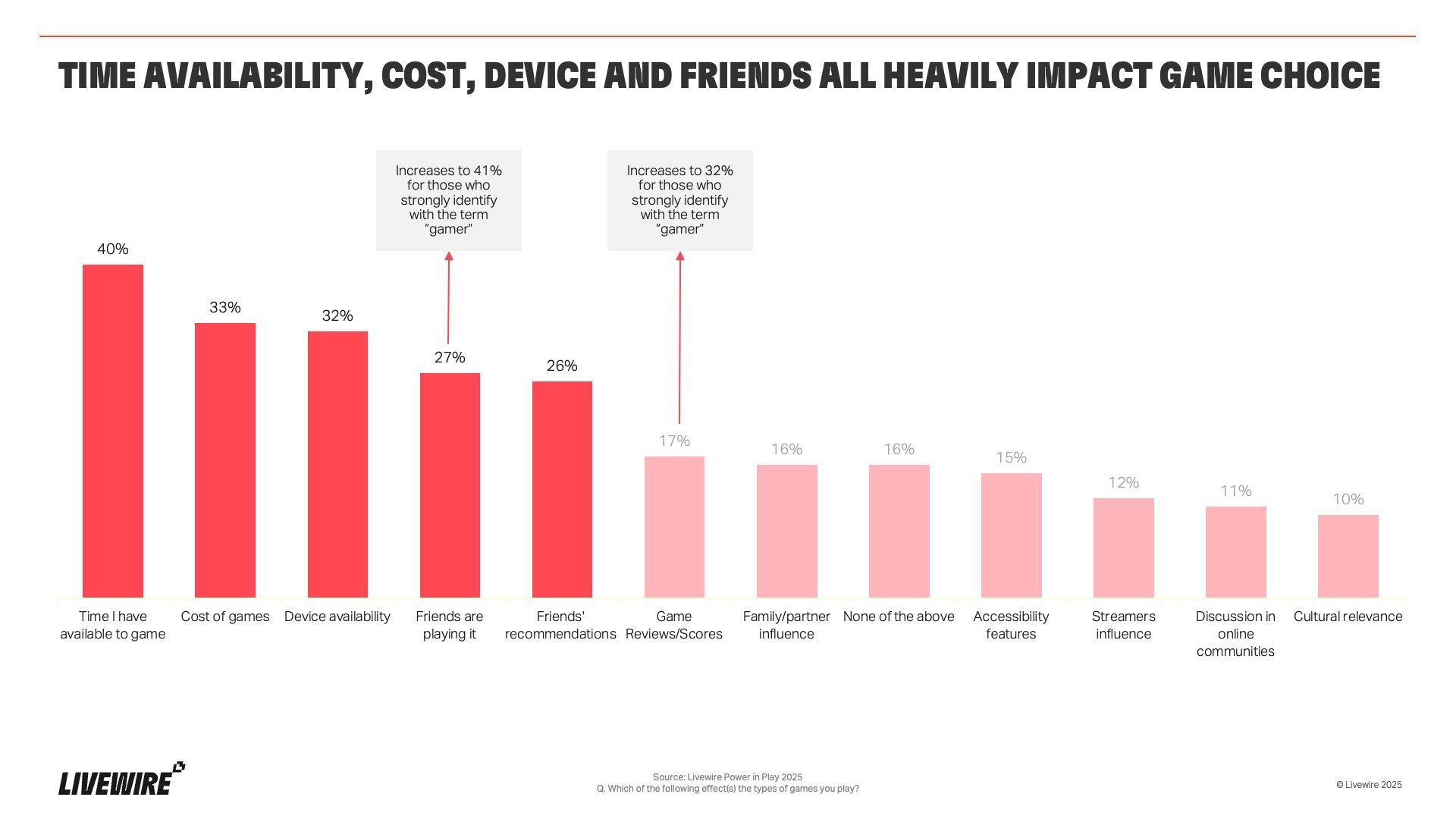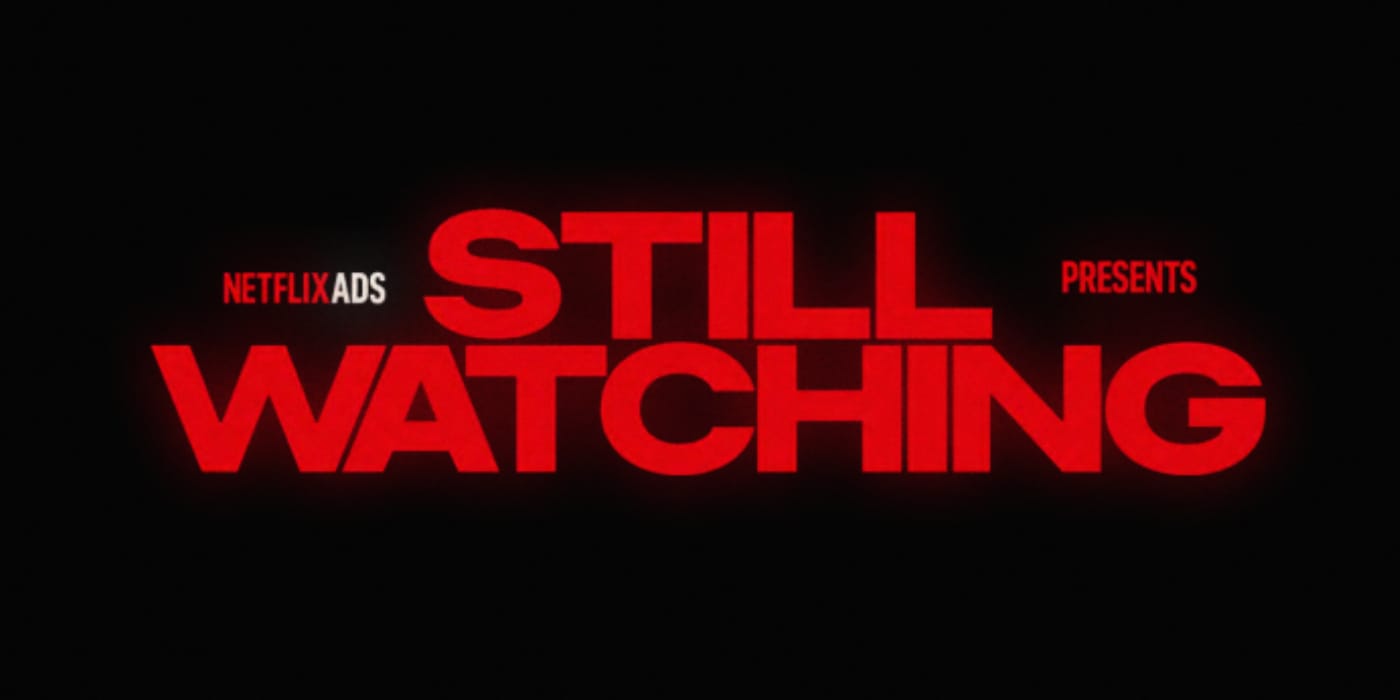- The SEG3 Report
- Posts
- Even in a recession, fans won't quit this
Even in a recession, fans won't quit this
& EA partners with Stability.ai to co-develop AI models, tools and workflows + Netflix share report on how and why Gen Z and Millennial audiences stream - and what it all means for advertisers
Hello hello. Welcome back to Edition #83 of The SEG3 Report!
Before we dive in, a reminder that Super Early Bird passes for SEG3 LA end this Friday 31st October. Don’t get a scare this Halloween and book your seat before then ⤵️
Contents: Edition #83
Is it game over for the term Gamer?
Livewire and PMCI Play (Publicis Media’s gaming division) just released Power in Play —a global study surveying over 2,400 players across the US, UK, Canada, and Australia, with the findings sharing insights on how culture, gender and life stages shape the gaming experience.
TL;DR:
Identity for people who play video games, is tied to titles, genres and devices, not broad terms like gamer.
Gaming is essential, with people cutting film and music before games, and 82% use it to manage stress (90% for Gen Z).
Friends fuel discovery and investment - with 1 in 4 choosing games because their circle plays them, proving gaming is still a social funnel.
Gaming isn’t just a pastime; it’s one of the most important cultural arenas where people build identity, connection and even resilience.
And in new data from Livewire & PMCI Play, we get a deep insight into how players really see themselves, and how that changes how brands should think about showing up.
Why does it matter?
For years, “the gamer” was treated as a single archetype.
But gaming is fluid. Players move between titles, genres and devices depending on their mood, identity or stage of life. For example, someone might be grinding Valorant one month, hopping on Roblox with their younger sibling the next and winding down with Football Manager after work.
That fluidity is both the opportunity and the challenge. Brands that still see gamers as one fixed identity will miss the reality that these are communities in motion, and they expect to be recognised wherever they play.
So, what’s the data say?
Think of it as three layers that explain why gaming has outgrown the old archetypes:
1 - Identity
The label of “gamer” doesn’t resonate like it once used to.
64% of players don’t strongly identify with the term, and only 22% of women are comfortable with the term, even though nearly half say gaming is central to their lives.
But it’s not a rejection of the culture - just a redefinition and proof that gaming has become more fluid, inclusive and personal.
So if brands still lean on the outdated “hardcore gamer” stereotype, they’ll miss the cultural breadth of the audience.
2 - Staying Power
When budgets tighten, gaming stays. The study shows that gaming is one of the last categories people cut; ranking above film, music, and live events.
For marketers, this resilience matters. In a world of media fragmentation, gaming is where attention consolidates, and stays.
And there’s good reason why gaming is no longer discretionary, but essential.
And that’s because players are not just seeing it as entertainment, but as a way to help them manage stress (82%), with that figure rising to 90% among Gen Z.
Given gaming is an outlet for many players, it makes it more high stakes for brands to understand the culture and driving force behind players engagement with a title, genre or device, because get that wrong, and they risk coming across as tone-deaf.
3 - Community
What’s motivating players to engage or invest with a certain title, genre or device?
Friends - they are shaping the funnel. 27% of players choose games because their friends are playing them, and 26% say recommendations matter. Gaming is still primarily a social activity, so if your game doesn’t have strong social hooks or ways for players to bring friends along, you’re leaving a big growth lever on the table.
So the next time you’re building a campaign, don’t think of a homogenous blob of “gamers.” Think of shifting communities who jump between titles, genres and devices - each with their own reasons for showing up, whether that’s identity, an escape or to socialise.
Closing Thoughts
Power in Play confirms what many already feel - gaming has moved from subculture to cultural scaffolding. It’s where connection is happening, where people are building and where they seek refuge from everyday life.
So for brands, it’s time to take that seriously. Not as a trend. But as the new table stakes.
Check out the full Power in Play research study here.
Electronic Arts partners with Stability.ai to co-develop AI models
Electronic Arts (EA) has announced a multi-year partnership with Stability AI to co-develop generative AI models and tools for game development. The collaboration will focus on building new AI systems to support the creation of in-game assets, environments and other production workflows, with the goal of integrating these tools into EA’s development pipelines across its studios.
TL;DR:
PIF’s investment into EA specifically called out AI innovation - this partnership is likely step 1.
AAA game development is in a tricky spot - with spiralling costs and live-service games making fans want content faster, innovation is needed in the production process to make it viable.
GenAI is inevitably going to become part of game development - and with EA, alongside Supercell and others experimenting, it will soon surface the use cases that are actually beneficial to the creative and development process.
EA is one of the biggest publishers in the world, with franchises like FC, Madden (which it just renewed in a long-term deal with the NFL), Battlefield (with the recent Battlefield 6 launch being the most successful in the franchises history) and The Sims, all requiring vast pipelines of content. From characters and dialogue to environments and live-service updates, the demand for assets is pretty unrelenting.
GenAI promises to reduce some of that load by helping artists and designers rapidly prototype ideas, automate repetitive tasks and test out new concepts in minutes instead of weeks. And so, EA partnering with Stability AI, best known for Stable Diffusion, is an intriguing crossover.
So, why does it matter?
What’s interesting is that this comes just weeks after EA agreed to a $55B acquisition by PIF, Silver Lake and Affinity Partners. In that press release, both EA and PIF leaned heavily on AI innovation as a pillar of EA’s next chapter, and so this deal with Stability AI feels like step 1 in that new strategy.
So, why should you care?
Because AAA development is going through a necessary shake-up. The model of taking 5+ years to ship, costing hundreds of millions, and essentially forcing publishers to bet the business on each release, is a fragile, high-stakes strategy where some win big, but many lose big too.
Marry that up with the fact that fans have now been conditioned by live-services game to expect more content, faster updates and always-on experiences, and you see why AAA studios are between a rock and a hard place.
And that’s the context that is likely driving EA’s partnership with Stability AI. The hope isn’t that AI will make the games for them, but that creative teams can use GenAI tools to cut costs, accelerate production, and free their team up to spend more time on the work that actually adds value.
As Rick Stringfellow, EA’s Head of Visual Content, put it:
EA has always been, and will continue to be, at the forefront of technology, innovation, and play...partnerships like this are how we evolve the craft of game-making and give our teams the tools to tell deeper, more meaningful stories.
Closing Thoughts
It’ll be an interesting one to track, not least because EA aren’t the only ones experimenting here. Studios everywhere are testing GenAI across art, workflows, UA and even new formats altogether. Supercell, who’ll be speaking at SEG3 LA in 6 weeks time, have gone as far as setting up an AI Innovation Lab to explore how AI could help create entirely new entertainment categories, test concepts before full-scale production, and even think about what an AI-native game might look like.
Either way, it feels like we’re only at the very beginning of seeing what GenAI might actually do for game making, and experiments like this will shift the conversation forwards, and enable us to see what’s good, and what’s a dud.
Netflix releases Still Watching Report 2025
Netflix has published its Still Watching 2025 report, surveying 9,000 Gen Z and Millennial viewers across 12 regions to understand their viewing habits, fandom behaviours and attitudes towards advertising.
TL;DR:
Discovery is the driver: 78% of Gen Z and Millennials go to streaming to find something new, and 79% say they love discovering new culture, including brands.
Niche matters: 68% say they’re fans of at least one programme or film with a specific, smaller audience - showing fandom thrives beyond just big IPs.
Fandom = identity: 72% of Gen Z say being a fan is core to who they are, and 87% share shows with friends, fuelling a fandom flywheel of growth.
Brand affinity: 74% are more likely to buy from brands aligned with their fandoms, and 71% follow or want to follow brands tied to their favourite shows.
Streaming still commands attention: 70% admit ignoring their phones while watching, and over 70% say they actually pay attention to ads when they fit the story.
Real-world influence: Content is inspiring lifestyle shifts - from hobbies (62%) to travel (61%).
Why should you care?
Because we went through the full 39 pages so you don’t have to (you’re welcome!) - but mainly because Netflix is a central part to global audiences consumptions habits, so if you’re in the game of building fans, telling stories or putting your brand into culture, you need to understand their subscriber bases behaviours.
So, what were the key findings?
Conveniently, Netflix split the report into three themes; content variety (and its effects), the fandom flywheel & what’s driving connection with audiences.
And here’s what stood out to us:
1. Discovery on streaming is engineered, not accidental
For those of you who attended SEG3 London this summer, you would have heard from Netflix about the work that has gone into tagging content in thousands of ways (with the help of AI), and how that insight is now powering targeted recommendations and delivering hyper-personalisation for subscribers.
And it’s working, as nearly 8 in 10 young viewers go to streaming platforms with the intent of finding something new. And finding it they are, with 68% saying they’re fans of at least one niche programme, proving that smaller, specific stories have just as much pull (if they can be discovered / surfaced). This lines up with the Fandom & Carat report we dived into in Edition #80, where 34% of fans spend time on micro moments i.e. the more niche content or IPs.
But that curiosity doesn’t stop at shows, with 79% saying they love discovering new things in culture, from food to fashion to brands. Whether it’s a rom-com (91%), a cooking show (83%) or a documentary (90%), Gen Z are happy to stumble across products and ideas along the way.
What this means for you: For the love of god, make sure your long-tail content is tagged, searchable and shareable so audiences can actually find it. And if fans are actively looking for something new, you don’t need to chase them - you just need to show up where their curiosity already lives, and they’ll find you.
2. Fandom is identity
Supporting your favourite sports team, film or artist is a core part of who fans are, with 72% say being a fan is core to their identity. And they want to share their fandoms with their friends, with 86% sharing new discoveries with their friendship groups, pulling more people into the orbit of your brand or IP.
Positively for advertisers and brands, that fandom spills into spending too, with 74% saying they’re more likely to buy from brands aligned with their favourite fandoms (there’s a nice stat for you sponsorship folk!), and 68% are keen to attend brand-sponsored events tied to shows they love.
What this means for you: People don’t just like stuff anymore - we all eat, live and breathe our fandoms. Give people access, pique their interest, and then let the best referral mechanism - word of mouth - work its magic to get the fandom flywheel spinning even further (and faster).
3. Streaming is still one of the few places with undivided attention
70% of viewers said they’ve ignored their phones because they were so interested in a show. Whilst that number should be taken with a healthy dose of skepticism (as viewers are not engrossed every time they consume on Netflix), it does go to show that if the content you produce is engaging enough, your fans will fully immerse themselves in it.
And intriguingly, there’s data to suggest that consumption of shows is actually changing behaviours, with 62% saying a show inspired them to try a new hobby (good news for the yet to be released BTS sports series!). In other words, content can, and is, having a cultural influence by driving impact IRL.
What this means for you: Capture attention, then do something with it. With the right story, it doesn’t just entertain but can also be the entry point into your ecosystem.
Closing Thoughts
People want to discover, they want to build identity through their fandoms, and if the story is good enough, they’ll give you their full attention (and maybe even change their habits because of it).
So for anyone in the business of making fans, it can’t be understated how important your content strategy is; it needs to show up in the right places/platforms, tap into the right communities and their motivations, and delivers stories worth talking about.
Because that’s when the fandom flywheel will really start spinning.
In other news this week:
EA Sports & NFL extend Madden partnership: read here.
NHL signs licensing deal with prediction markets company, Kalshi: read here.
Xfinity becomes Official Video Partner of the NBA & WNBA: read here.
Perplexity signs deal with Samsung to bring AI engine to smart TV’s: read here.
OpenAI launches browser; ChatGPT Atlas: read here.
MLS releases numbers for viewership, attendance, digital and socials from 30th regular season: read here.
PSG launches PSG Labs Batch 2, with 14 strategic innovation priorities: read here.
Burnley FC Innovation Hub applications close this Friday 31st October: read here.
Dallas Cowboys team up with Zombie Escape on Fortnite: see here.
Meta experimenting with ad effectiveness tools: read here.
Samsung partner with Jonas Brothers to offer Samsung TV Plus customers the opportunity to pick the setlist live: read here.
Headspace partners with Moonbug Entertainment’s CoComelon: read here.
Nexus partners with Sonic Rumble: read here.
AWS debuts real-time bidding for advertisers: read here.
Anzu launches 2025 Guide to Gaming Audiences report: read here.
Newzoo releases 2025 Global Games Market report: read here.
Peroni Nastro Azzuro challenges streamers to race to zero: read here.
BBC Sport release tender for digital video services: read here.
YouTube sponsorships surge 54% as brands bet on creators: read here.
Working on anything cool, or have a press release you would like us to cover? Send it in for the chance for it to be covered in next week’s edition!
What'd you think of the SEG3 Report? |
That’s all for now everyone - thanks again for reading the latest edition of The SEG3 Report, and if you found it of interest, please do consider sharing with a colleague or friend!



